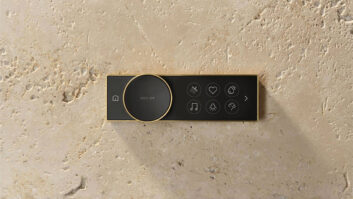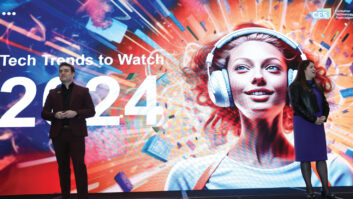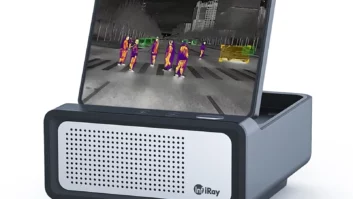Here is an alphabetical list of MP3 suppliers and the types of headphone-style portable digital players they will be introducing today at International CES.
Axion: The brand plans to launch two flash-memory A/V portables, both using removable SD cards, in the first quarter. Both will play MPEG-4 videos and music in the ASF, WMA and MP3 formats. They’re also JPEG viewers.
The AXN-9250 with 2.5-inch TFT LCD screen will retail for a suggested $129, and the AXN-9350 with 3.5-inch screen for a suggested $169. Both feature built-in speaker, 3.5mm A/V input/output jacks, stereo headphone jack and USB cable.
The brand was launched in North America in 2004 by Chinese manufacturer Action Electronics. The brand also appears on LCD TVs, TV/DVD combos, portable DVD players and handheld TVs.
Other new Axion products at CES include five portable DVD players with 4.1-inch to 10-inch screen sizes.
Cowon America: An A/V-playing flash-memory portable will be unveiled to complement a current HDD model. The iAudio U3, in 1GB and 2GB variations, is only 1.2 inches by 2.8 inches by 0.7 inches in size and weighs 1.14 ounces, but it features a 260K 1.2-inch TFT LCD screen.
It’s an MPEG-4 movie and music player as well as a text and JPEG photo viewer. It decodes music in the MP3, OGG, WMA, ASF, FLAC and WAV formats. The battery lasts 20 hours during music playback. Additional details were unavailable. It was due to ship in late December or early January at a price to be determined.
The flash model will join the HDD Cowon A2, available in 20GB and 30GB versions at a suggested $399 and $499, respectively. It records music and video directly from a TV or other video source from their NTSC or PAL analog-video outputs, and it rips and encodes music in MP3 directly from audio sources. It also features FM tuner/recorder and voice recorder.
Features include 4-inch 16:9 LCD screen, text viewer and image viewing of JPEG, BMP and PNG files. It decodes video in the AVI, DiVX, XviD, ASF, WMV and MPEG-1 formats. Music decoders are MP3, WMA, OGG and WAV.
The battery delivers 18 hours of music playing time or 10 hours of video playback. Support for purchased and rented WMA and WMV downloads is in the works.
Dream’eo: The company expects to be the only supplier of an A/V portable with built-in GPS navigation when it ships its second-generation device, called Solo. It displays maps on a 3.5-inch LCD, gives turn-by-turn driving instructions, plays MPEG-4 videos and plays MP3, WMA and WAV music files. It also stores any type of digital file.
Additional details were unavailable.
Handheld Entertainment: The company will expand its line of ZVUE flash-memory A/V portables with the addition of four more models, all supporting playback of DRM-protected WMA and WMV downloads, whether purchased or rented.
They also play back WMA and WMV downloads from www.zvue.com, including 1,000 short comedies from Fun Little Movies, a production company whose work has appeared on multiple cable-TV channels.
The $99-suggested 200A and the $129 250 offer identical features except for the 200A’s use of four AAA batteries instead of a lithium-ion rechargeable battery. They sport 2.5-inch 160 by 240 LCD screen and come with removable 128MB MMC card, SD/MMC slot and no embedded memory. They also feature USB 2.0, play MPEG-4 and protected WMV video, and play MP3 and protected WMA music. Both weigh 9 ounces and are 108 mm by 73 mm by 27 mm in size. When playing music, the 200A’s AAA batteries last up to eight hours, and the 250’s battery lasts five to six hours.
The $219-suggested 400 and the $299 500 offer a mix of embedded and removable memory, the former shipped with 512MB internal memory and the latter shipped with 1GB and Wi-Fi. They also record direct from a TV’s analog outputs and accept removable media in the SD/MMC and Compact Flash Type II format up to 8GB.
Both come with 3.5-inch 320 by 240 display, weigh in at less than 8 ounces, and are 194 mm by 84 mm by 16 mm in size. The lithium-polymer battery runs up to five or six hours when playing music.
iRiver: Small A/V portables with big screens and point-and-click menus are the hallmarks of iRiver’s introduction of the flash-memory based U10 and HDD-based and 30GB-HDD M20.
Both come with cradles with line inputs to record music directly from a CD player in MP3 form. They also feature line outputs to play stored music through stereo systems. The M20 cradle adds video output to display stored video directly on a connected TV. Neither records directly from a living room TV; they play back video, including TV video, stored on a PC.
The U10, the company’s first flash-memory player to store video, is due in 512MB and 1GB capacities at a suggested $199 and $249, respectively. The M20 uses the Microsoft Portable Media Center (PMC) platform. Pricing and ship date weren’t available at press time.
The U10 is 2.7 inches by 1.8 inches by 0.6 inches but features a 2.2-inch color display with “direct-click” interface, enabling users to navigate a menu by pressing on the outer edges of the screen. It displays Macromedia Flash animation and games, JPEGs and MPEG-4 video at up to 15 fps QVGA. In audio, it plays MP3, protected WMA downloads (purchased and rented) and OGG. Other features include FM tuner, voice recorder, SRS 3D WOW audio enhancement and rechargeable battery that delivers 28 hours of audio playback time.
The M20 is only 4.11 inches by 2.5 inches by 0.87 inches but features 2.2-inch color screen that displays function names that are selected by a click wheel. It plays protected WMA music and WMV video (purchased and rented) from authorized sites. Supported video formats at up to 30 fps are WMV, AVI and ASF. Supported audio codecs are MP3, WMA and ASF. Other features include FM radio and recording, voice recorder and text and JPEG viewing.
It will likely be released initially in a 30GB version, with other capacities to follow.
The company will also relaunch its 20GB H10 HDD music player/photo viewer, said to be the first to be controlled from a docked Xbox 360 and first to play protected downloaded music — including rented music downloads — through an A/V system connected to the Xbox 360.
With a firmware download, other H10 models with 5GB and 6GB capacities will integrate deeply with Xbox 360 to deliver the same capabilities.
LG Electronics: The company is launching its first three digital portables in the United States under its own brand, having offered some Zenith-branded models in years past. All are equipped with video-playback capability whether incorporating flash memory or HDD. One uses Microsoft’s Portable Media Center (PMC) platform. All ship in the first quarter. Some are among the industry’s first with OLED video and photo displays, and one flash-memory model offers 60 hours of music-playback time on its lithium-polymer battery.
The unit, with 60 hours of battery life, is the wearable 1GB flash-memory FM30. It is a 2.4-inch by 1.6-inch by 0.5-inch, 1.8-ounce model with 1.77-inch 260K color OLED display, and it stores and plays MPEG-4 video, acts as a photo and text viewer, and decodes music files in the following formats: MP3, protected WMA downloads (purchased or rented), OGG and ASF. Supported image formats include JPEG and BMP. The suggested retail is $199.
The step-up $299-suggested 8GB HDD model, the JM53, offers the same audio and video playback capabilities and adds extended-life battery, allowing for up to 21 hours of music-playback time on one charge. It’s 3.9 inches by 1.9 inches by 0.5 inches and features a 1.77-inch 260K color OLED display.
At the top of the line, the $549-suggested 20GB PM70 Portable Media Center features 4.3-inch 16:9 display, built-in stereo speakers and PIM functions. Although based on Microsoft’s Portable Media Center (PMC) platform, it also records directly off a TV, PVR or other non-copy-protected video output via composite input. It doesn’t time-shift, however. It also displays video content on a connected display via its composite output. It plays downloaded WMV files, either purchases or rented, from authorized download sites. Additional supported video formats include DiVX, Xvid and AVI.
Panasonic: The company plans new models later in the year and doesn’t expect to display here.
Philips: An 8GB HDD portable said to be light and small enough to wear is the GoGear Micro Jukebox, a 3-ounce model that’s only 2.2 inches by 3.4 inches by 0.6 inches in size, including FM tuner. The MP3 player/photo viewer plays music for up to 18 hours between recharging. It’s PlaysForSure-certified for audio, so it can play downloaded WMA files (purchased or rented).
It ships in May at a suggested $249.
RCA: The new headphone A/V portable that records directly from a TV or DVR is the $399-suggested 20GB Lyra X3000, which adds time-shifting capability to its predecessor’s TV-recording capability. Recorded video can be displayed on a connected TV via composite output.
Compared with its predecessor, it’s 24 percent smaller, 270 percent brighter with a wider viewing angle, has simpler user interface and 50 percent longer battery life, delivering 4.5 hours of video playback. Other improvements include a speaker, docking station, remote control and microphone. The comparison is to the RD2780, not the RD2782 that was shown at last year’s CES but not delivered.
Like before, it features 3.6-inch color TFT display, external speaker, JPEG viewer, MP3 encoder to rip CDs without going through a PC and playback of MP3/WMA audio files and MPEG-1, -2- and -4 video files. It adds playback of rented WMA music downloads.
Macrovision technology prevents the copying of DVDs. An SD/MMC slot is included.
Ritek: Through its U.S. subsidiary Advanced Media, the supplier of Ridata-brand optical, HDD, and flash-memory storage media plans to display its first A/V portable. It’s the flash-memory Ole 8100, available in the first quarter in 1GB and 2GB versions at an everyday $229 and $279, respectively.
They play music and MPEG-4 videos and they display digital photos, even though they’re only 2.6 inches by 2.6 inches by 0.7 inches in size and weigh less than 3 ounces. Despite their diminutive size, they sport a 2-inch LCD screen.
They play MP3, WMA, OGG and AC3 audio files. Video is played back in the AVI, VOB, DAT and MPEG-1, MPEG-2 and MPEG-4 formats. It supports JPEG and YUV images. Other features include voice recorder, and it outputs video to the NTSC and PAL TV standards.
Samsung: New features and greater memory capacities mark Samsung’s flash-memory introductions, which include one of the industry’s first XM-ready models. It controls an XM Connect and Play antenna/tuner, plays XM programs through a connected sound system and time-shifts XM satellite radio programming.
Also new: a 4GB model and another model said to be the industry’s first with built-in speaker combined with 2-megapixel camera. Olympus launched two HDD MP3 player/cameras last year with 1.22-megapixel resolution.
The XM time-shifting MP3 player, called neXus, is promoted as the first flash-based XM-ready MP3 player. It’s due in the first quarter at an unannounced price in 512MB and 1GB versions. It plays MP3 and protected WMA files (purchased and rented) for up to 16 hours on its rechargeable battery, stores XM programs for later playback and lets users permanently store or delete individual time-shifted XM tracks. Songs in all three file formats can be mixed into custom playlists. The XM tracks remain on the device for as long as an XM subscription is current. When the XM subscription lapses, the music lapses within 90 days.
Users can also “seamlessly” purchase saved XM tracks as protected-WMA downloads, through the XM+Napster digital download service, for playback on PCs and other portable devices.
The YP-Z5 is the 4GB flash model, said to be the first 4GB flash model to play rented WMA downloads. It features large 1.8-inch color TFT screen to display JPEG photos and album art; touch-pad interface, 24-hour rechargeable battery, aluminum body and native decoding of MP3, WMA and OGG audio files. It ships in February at a suggested $249. A 2GB version retails for a suggested $199.
The MP3-camera, the YP-D1, is also available in two flash-memory capacities: 1GB for $249 and and 2GB for $299. It also plays MPEG-4 videos transferred from a PC on its 1.8-inch color TFT LCD screen. A USB Host device, it also displays images and videos on USB-equipped displays.
Other features include 4x zoom, FM recording, voice recording and playback of MP3, OGG and protected WMA files (purchased or rented). It also displays text files.
The $449-suggested, HDD-equipped YM-P1 is Samsung’s first portable media player to record directly from a TV or DVD’s analog outputs and display that content on a connected TV, with VGA resolution, through its own analog A/V output. The device, due in February, also stores and plays back protected-WMV video downloads and other video transferred from a PC in the MPEG-4, DiVX, Xvid and AVI formats. It’s not a Microsoft-platform Portable Media Center.
Content is stored on a 20GB HDD and viewed on a 4-inch 16:9 color TFT LCD screen. Other features include FM radio, voice recording, SD card slot and USB host to display content on USB-equipped displays.
Next time you go to Korea, you can also use it to view digital TV broadcasts over a network built expressly to transmit live TV to handheld devices.
Toshiba: The company will show its first video-capable headphone portables, which are based on Microsoft’s Portable Media Center (PMC) platform. Toshiba’s first flash-memory music portables, announced late last year, will also be displayed.
All are the company’s first digital portables with FM radio, FM and voice recording, and WMA Lossless decoding, which joins native MP3, WAV and lossy-WMA decoding. Like the HDD models in the company’s 2005 lineup, they also support WMA subscription downloads.
The new models will also be the company’s first to use Windows Media Player (WMP) 10 for downloading, ripping and music management. Current models use WMP 10 for downloading from authorized Web sites and Toshiba-supplied software for ripping and managing music on a PC.
The 512MB and 1GB flash-memory models, the $129-suggested MEP-05SR and $179 MEP-10FK, ship in January or February with 1-inch color LCD to view photos. All use embedded memory with no memory card expansion slots.
The two new HDD models are the 30GB S30 and 60GB S60, each available in the spring in black, white and metallic blue with 2.4-inch color screen to view video and photos. Despite the addition of video playback, they’re smaller than music-only Gigabeat HDD models.
The new units play video in WMV and MPEG-4 formats, but WMP 10 software on the computer will transcode AVI and other formats to WMV for native playback on the devices. They will be compatible with subscription (“rented”) music downloads as well as with protected rented video downloads, which will expire on the devices if a time-out is included in the video’s digital-rights-management rules.
The A/V portables deliver 20 hours of compressed-music playback and about three hours of video playback.
In a change from the current models to meet PMC requirements, they don’t use the PlusTouch cross-shaped touch pad to control functions. A cross-shaped control panel features buttons at each end of the cross.
The four current HDD models feature 10, 20, 40 and 60GB capacities.













